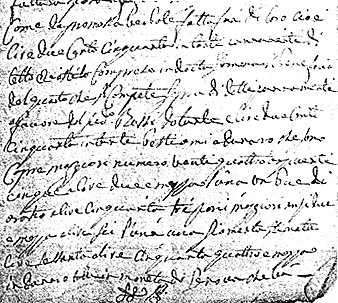
As a contrast to the dowry of Gaetana Allegro, a woman from an family of urban artisans, this example is from a marriage between pastoral families in a rural setting. The document is a notarial act recording the receipt of the dowry dated 19th August 1788, [AD Corse-du-Sud 3E 1858]. Gio Domenico Milanini q Gio Pietro living at Cantoli a summer transhumance hamlet near Quenza, southern Corsica has received 500 lire as the dowry of Anna Maria Rossi from her father Don Giovanni Rossi q Anton Geronimo. The couple married 8th November 1788 almost three months after the contract date.
Gaetana's dowry from Ascoli was composed of linen, clothes, jewelry, furniture, a house and land all listed in detail. In the Corsican example, the linen and clothes are noted briefly while the livestock which make up almost half the donation, are listed in full. Apart from cases where there were no sons, landed property was rarely given to women in Corsica and in some cases was entailed to prevent it passing to females except as a last resort.
The Corsican quarto was the amount which would automatically revert to Anna Maria's family in case of widowhood. The Corsican contract and that from Ascoli, illustrate the wide range of differences to be found in dowry provision and the differential impact of that provision on the gender linking of property and processes of divergent devolution.
In the case of Ascoli, women's rights to dowry property take precedence over son's inheritance claims. Husbands have only limited rights over their wives' dowry property which reverts in full to the wife and her children in the case of the husband's death. In addition widows, even without children, are entitled to a portion, either a quarter (quarto) or a third (meffio) of the husband's estate. A much higher percentage of dowry goods - specified linens, high value clothes, jewelery, vigne (small garden plots) - are strongly gender linked, almost exclusively associated with the female domain. Trousseau as treasure is a marked feature of Ascoli dowry arrangements well before the late nineteenth century (c.f. Schneider, J. 1980).

.... that is 250 lire in all sorts of bedlinen and clothes comprising in that sum the benefit of the quarto that applies to the said linen in favour of the said Rossi the dowry giver, and 250 lire in all sorts of livestock and cash, these are: 24 or rather 25 adult goats at 2½ lire each, one plough oxen at 50 lire, three adult pigs or rather 2½ at 6 lire each, one mare valued at 70 lire and 54½ lire in cash all in Genovese coin.